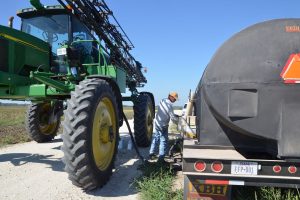Farm tractors and other machinery are critical to the livelihood and productivity of the farm. Failure to protect them from natural disasters, such as floods, can put an agriculture producer out of business. If at all possible, move all tractors and implements out of flood-prone areas before it’s too late. However, if circumstances prevent their removal, there are some things you can do to recondition or restore this equipment immediately after a flood to resume operation and prevent permanent rusting and corrosion.
I. TRACTORS

Never attempt to start a tractor that has been flooded without properly cleaning and servicing it, even if the tractor starts. Water and dirt can get into the bearings, causing wear. If possible, do not tow a tractor that has been flooded. Water and dirt may have entered the transmission.
The extent of cleaning will depend upon which parts of the tractor were submerged. If only the wheels were submerged, wash off all dirt then remove the wheels and bearings from the spindle. Clean the spindle with solvent, clean the bearings, and pack the bearings with fresh grease. If the bearings are old, this would be a good time to replace the bearings with new ones. Reassemble the bearings and hubs back on the spindles. Refer to the service manual for proper torque on the spindle. For kingpins and bushings, flush out the existing grease with fresh grease.
If the transmission or part of the engine was submerged, water and dirt may have gotten through seals or gaskets. Drain all oil from the engine and transmission and inspect for signs of water. If you do not see any water in the oil, then you don’t have a leak. Refill with fresh lubricant. If you see water in the oil, remove the oil pan and clean the engine crankcase and transmission housing thoroughly. Remove and replace oil filters.
If the floodwaters completely submerged the engine, it is likely that water and dirt have entered the engine and transmission. This requires a complete engine overhaul. Unless you are qualified, this can be done through your tractor dealer.
2. EQUIPMENT
The cleaning requirement of equipment will vary with equipment design, parts, and level of water and dirt contamination. The following suggestions address those operations most common to farm equipment.
Cutting Parts: Remove knives and cutter bars from mowers and combines. Clean and dry them. Apply a light coat of oil and reassemble. Inspect the inside of combines and remove accumulated dirt, debris, or water.
Belts: Inspect belts for tears or cracks. Repair and replace them as needed.
Bearings: Clean and grease bearings without protective seals. Non-sealed bearings can sometimes be cleaned by forcing grease into them until contaminated grease oozes from the sides of the bearings. Wipe off excess grease.
Sealed, factory-lubricated bearings may be equipped with grease fitting, and can be damaged if you attempt to force grease into them. Sealed bearings will not likely be damaged from flood water.
Gear Cases: Inspect enclosed gear cases for water or grit. Water may be present below the oil. If you find water or grit, or if you are in doubt drain the gear case, flush it with kerosene and refill with clean oil.
Gears and Sprockets: Clean exposed gears and sprockets with kerosene or cleaning solvent. Coat gears with light oil.
Chains: Remove and soak chains in kerosene or solvent for several hours. Allow solvent to drain out. Soak chains for several hours in light oil. Drain off excess oil. Replace chains on machine.
III. REFERENCES
Reconditioning Equipment. Adapted by UF/IFAS from: Document DH-077, IFAS Disaster Handbook for Extension Agents. University of Florida Cooperative Extension Service.
Reconditioning Flood Damaged Tractors. North Carolina Cooperative Extension.
